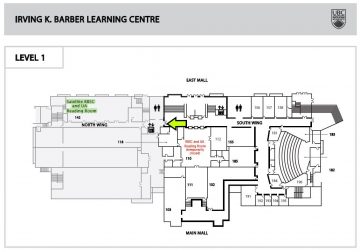Browsing UBC Open Collections, one can find several instances of comparison between Western Canadian mountain ranges and the Swiss Alps. This postcard book, for example, labels the Rockies as the “Switzerland of America”.

20 Beautiful View of the Canadian Pacific Rockies, The Road through the Switzerland of America (Uno Langmann Collection, circa 1920s)
Like the Swiss Alps, Western Canada’s mountainous landscapes boast jaw-dropping elevation, striking snow-capped tips, and spectacular greenery, providing justification for these comparisons. This stereograph names Mt. Sir Donald, located within the Columbia Mountains, the “Matterhorn of the North American Alps”, with its back caption claiming that the “scenery is quite like that of the Swiss Alps, but on a much grander scale”.

Mt. Sir Donald, the Matterhorn of the North American Alps, British Columbia, Canada (Uno Langmann Collection, 1903)
It’s no surprise, then, that in 1928, highly respected German-American film director Ernst Lubitsch chose to pass off our humble Rockies as their world-famous Swiss counterparts in his film Eternal Love. Several photos from the Uno Langmann Family Collection of British Columbia Photographs document the Lake Louise, Alberta shoot, permitting the viewer a behind-the-scenes glimpse into a fascinating era of filmmaking.

Lubitsch lying on wooden structure on set of Eternal Love (Uno Langmann Collection, 1928)
Created at the end of the silent film and beginning of the sound film era, Eternal Love has no spoken dialogue, but is accompanied by a musical score and sound effects, constituting it as a hybrid silent/sound film. It would be the last silent film for Lubitsch, as well as for its lead actors John Barrymore and Camilla Horn.
Shooting Eternal Love
Using Banff National Park’s stunning landscape as its alpine backdrop, Eternal Love tells the story of two Swiss lovers destined to be together despite being trapped in passionless marriages to other people. Filming locations include Sentinel Pass and the summit of Saddleback Pass.

Horn and Barrymore on location (Uno Langmann Collection, 1928)
The Uno Langmann Collection holds some remarkable images depicting Eternal Love’s direction and cinematography.

On set (1928, Uno Langmann Collection)
Photos also portray other integral behind-the-scenes moments, including the hair and makeup team preparing actors for their moment in the spotlight.

Actors getting ready (1928, Uno Langmann Collection)
Local Perspectives
Excerpts from the BC Historical Newspaper Collection give insight into the Canadian perception of the film shoot at the time, as well as its run in local movie theatres after its release.
An article from The Greenwood Ledge details how Barrymore refused the use of a double in his portrayal of “daredevil mountaineer” Marcus, only to sprain both ankles during the shoot.

The Greenwood Ledge, December 13th, 1928
A blurb in The Princeton Star’s “Here and There” section describes how the crew transported “Hollywood snow” to Lake Louise, only to learn it had been unnecessary upon seeing the vista covered in the real thing.

The Princeton Star, December 6th, 1928
Nelson, BC’s The Daily News advertises a screening at its local Capitol Theatre, describing the film as “searing, seething, cyclonic—a tempestuous heart drama”.

The Daily News, August 12, 1928
The Legacy of Eternal Love
After its original theatrical release, Eternal Love was considered lost for many decades. However, in 1990, a 16mm print was discovered in the film collection of actress and film producer Mary Pickford, and was subsequently rereleased in theatres with its original music and sound effects.
The film was never a massive commercial or critical success, with reviews at the time criticizing its weak script and at-times-overdramatic acting. Nevertheless, it has remained well-respected for its beautiful scenery and photography, confirmed by the stunning behind-the-scenes images that have since emerged.

Mountainside view of Eternal Love shoot (1928, Uno Langmann Collection)
While Eternal Love is certainly not considered one of the greatest films of all time, it features some major players in early 20th-century film and remains loved by many. And for Western Canadians at the time, the film’s local production was a source of excitement and pride.
Note: Photos from the Uno Langmann Collection depicting the Eternal Love film set contain some inaccurate metadata, including provided titles referring to the film as Le Roi de la Bernina (possibly its working title) and a description stating it was filmed in B.C. The Digitization Centre is aware of these inaccuracies, and will be correcting these errors after the completion of our digital asset management system migration.























